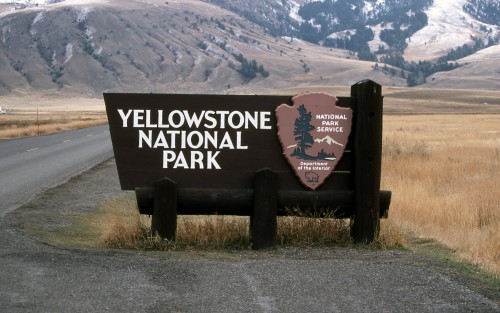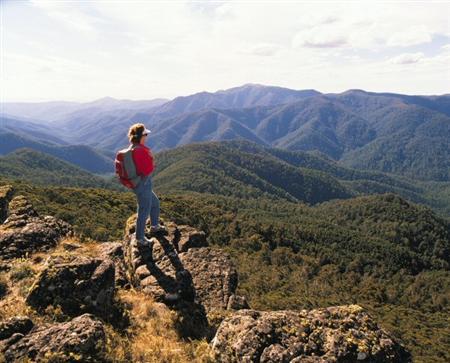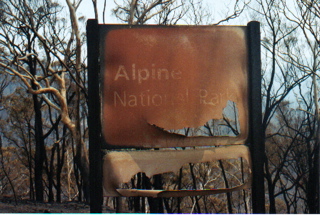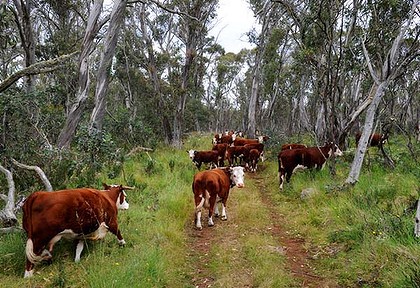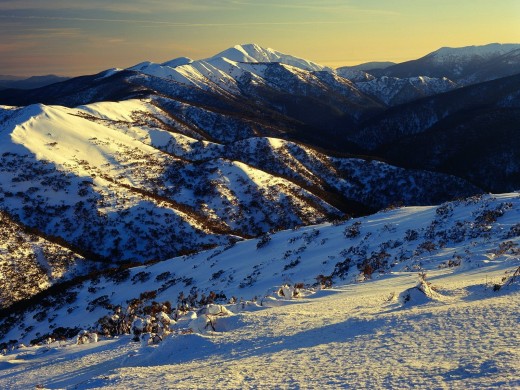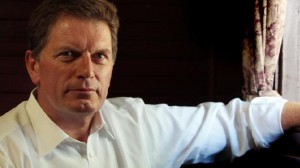Poachers in World Heritage, now game’s over!
Sunday, July 21st, 2013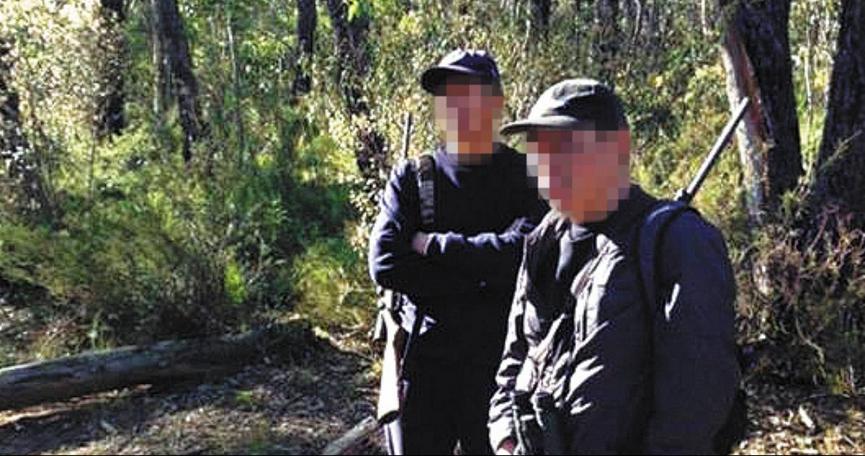 Illegal poachers caught in the Blue Mountains World Heritage Area on 15th June 2013
[Photo by bushwalker Darren Drew in Tigersnake Canyon, Wollemi National Park, at a time when 500 runners were participating in a marathon in the area]
Illegal poachers caught in the Blue Mountains World Heritage Area on 15th June 2013
[Photo by bushwalker Darren Drew in Tigersnake Canyon, Wollemi National Park, at a time when 500 runners were participating in a marathon in the area]
.
<< Two men were reported to be illegally hunting in NSW’s biggest natural tourist attraction, the Greater Blue Mountains World Heritage Area.
Blackheath bushwalker Darren Trew said he came across the hunters on a canyoning trip with friends on Saturday June 15. Over that weekend 500 runners from across the state had converged in that same region to participate in the second Glow Worm Tunnel Marathon, near Newnes. Mr Trew, who saw the men with their weapons, reported the matter to Lithgow Police, to the Game Council and to the National Parks and Wildlife Service.
Mr Trew:
“It’s madness. It was quite a shock to discover after 20 or more years of bushwalking. It’s quite disturbing, they said they were hunting deer and I told them they were not allowed to be here with rifles, it’s illegal, I called the police and they walked away.”
.
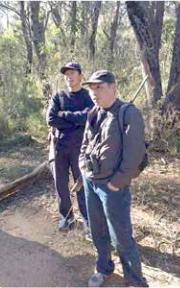 Photo by High & Wild
Photo by High & Wild
.
Mr Trew’s group took a photo of the men and said later that day about 20 people turned up to enjoy Tigersnake Canyon.
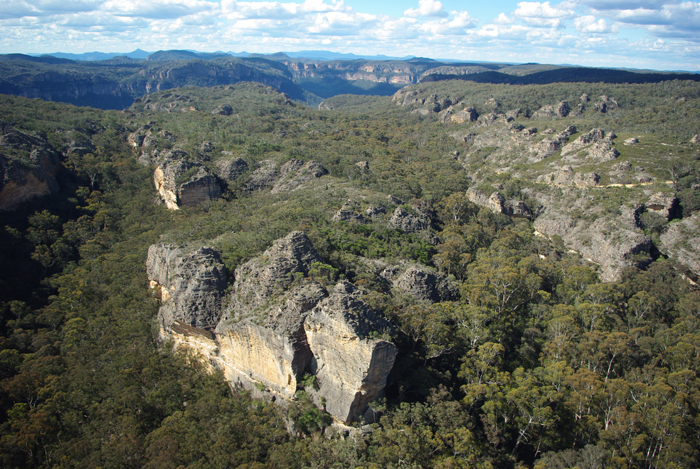 Glow Worm Tunnel Area, Wollemi National Park
Greater Blue Mountains World Heritage Area
[Source: NSW Government, ^http://www.environment.nsw.gov.au/nationalparks/parkWalking.aspx?id=N0051]
Glow Worm Tunnel Area, Wollemi National Park
Greater Blue Mountains World Heritage Area
[Source: NSW Government, ^http://www.environment.nsw.gov.au/nationalparks/parkWalking.aspx?id=N0051]
.
Glow Worm Tunnel Marathon race director Sean Greenhill of the Wentworth Falls based Mountain Sports said he was very concerned by the reports.
“It’s extremely disturbing to think that two men with rifles were hunting in a national park only a couple of kilometres from where 500 runners were conducting a legitimate activity in the same park — odds are small but the potential implications are horrifying. Mountain Sports doesn’t support hunting in any national park — why create such a dangerous precedent?”
.
“Unfortunately, some hunters have heard “you can now hunt in national parks” and assume it’s a free-for-all. With the Game Council promoting NSW as ‘the place to hunt’, this is only going to get worse.”
~ National Parks Association of NSW spokesman, Justin McKee
.
National Parks Association of NSW spokesman, Justin McKee:
“The incident highlights that Premier Barry O’Farrell’s promise that safety will be paramount does not definitely rule out the risk of illegal hunting in highly visited areas, including those where hunting is not allowed like the Greater Blue Mountains World Heritage Area.
Hunting in national parks is bad policy, it’s bad for tourism, public safety and the environment. It ruins the international reputation of our national parks brand that has taken 50 years to build up. Unfortunately, some hunters have heard ‘you can now hunt in national parks’ and assume it’s a free-for-all.”
.
A spokesman for Environment Minister Robyn Parker said the minister didn’t normally comment on operational issues but “obviously hunting in national parks is illegal and an investigation is ongoing”… [Ed: There is no public report that they caught, so it was a free-for-all that day]
[Source: ‘Armed hunters spotted in Blue Mountains world heritage area’, 20130626, by B. C Lewis, Blue Mountains Gazette (newspaper), page 7, ^http://www.bluemountainsgazette.com.au/story/1598489/armed-hunters-spotted-in-blue-mountains-world-heritage-area/; the lead photo of the two hunters was taken near Tigersnake Canyon and posted on Facebook 20130622].
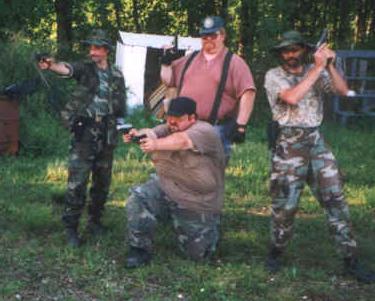 Weekend Warriors
all camoued up and ready to hunt!
Weekend Warriors
all camoued up and ready to hunt!
.
Game Council NSW ‘Code of Practice’ (so-called)
.
<< Ethical, safe and responsible hunting
.
- Awareness of relevant legislation
It is the responsibility of the holder of a NSW Game Hunting Licence to be aware of and comply with all relevant legisation relating to hunting, animal welfare and the use of firearms. - Safe handling of firearms
Where firearms are used, the rules for safe handling set out in the NSW Firearms Safety Awareness handbook, published by or under the authority of the Commissioner of Police, must be complied with at all times. - Permission required to enter land
A NSW Game Hunting Licence does not automatically authorise the holder of a licence to hunt on any land. The holder of a Game Hunting Licence must not hunt on any land without the express authority of the occupier of the land. - Target identification and safety
A game animal must not be fired at unless it can be clearly seen and identified, and the shot taken poses no discernible risk of injury to any person or damage to any property. - Obligation to avoid suffering
An animal being hunted must not be inflicted with unnecessary pain. To achieve the aim of delivering a humane death to a hunted animal:- it must be targeted so that a humane kill is likely;
- it must be shot within the reasonably accepted killing range of the firearm and ammunition or bow being used; and
- the firearm, ammunition, or bow and arrow, must be such as can be reasonable expected to humanely kill and animal of the target species.
- Lactating female with dependent young
If a lactating female is killed, every reasonable effort must be made to locate and kill any dependent young. - Wounded animals
If an animal is wounded, the hunter must take all reasonable steps to locate it so that it can be killed quickly and humanely. - Use of dogs
Dogs and other animals may be used to assist hunters, but only if:- their use is not in contravention to the Prevention of Cruelty to Animals Act 1979; and
- their use is with the permission of the occupier of the land concerned. >>
.
[Source: Game Council of NewSouth Wales, ^http://www.gamecouncil.nsw.gov.au/portal.asp?p=CodeofPractice].
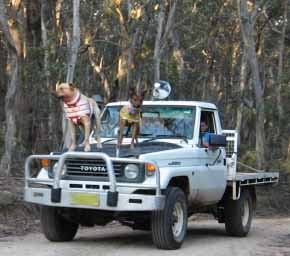 Game Council Code of Practice:
“Use of (pig) dogs: Dogs and other animals may be used to assist hunters, but only if:
Game Council Code of Practice:
“Use of (pig) dogs: Dogs and other animals may be used to assist hunters, but only if:
- their use is not in contravention to the Prevention of Cruelty to Animals Act 1979; and
- their use is with the permission of the occupier of the land concerned.”
.
May 2012: NSW Government allows hunting in national parks
.
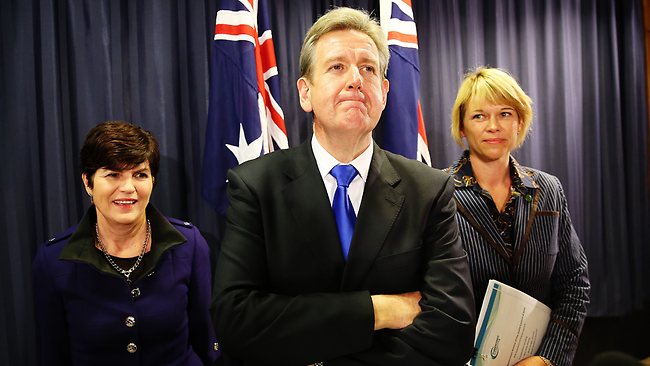 National Park’s chief custodian Environment Minister Robyn Parker,
with NSW Premier Barry O’Farrell and Primary Industries Minister Katrina Hodgkinson
announcing that shooting will be legal in national parks.
[Source: Photo by Craig Greenhill, The Daily Telegraph]
National Park’s chief custodian Environment Minister Robyn Parker,
with NSW Premier Barry O’Farrell and Primary Industries Minister Katrina Hodgkinson
announcing that shooting will be legal in national parks.
[Source: Photo by Craig Greenhill, The Daily Telegraph]
.
<< Hunting will be seen in 79 of the state’s national parks as part of a deal struck by the government (with the Christian Democrats and the Shooters and Fishers Party) last night in exchange for the sale of the state electricity generators.
New South Wales Premier, Barry O’Farrell: “We promised to revitalise the state’s economy, we promised to put additional funding into infrastructure… and the decision was based on the public interest and political realites.”
Despite O’Farrell’s pre-election promise that he would not open up national parks to shooters as hunting reserves, the Premier said that he has not broken his promise.
“There is a big difference between hunting reserves and restricted shooters under the direction of the Minster of the Environment assisting National Parks and Wildlife staff with the culling of feral animals.”
O’Farrell’s famous last words:
“Shooting will be safely and professionally run by the Game Council.”
.
In exchange for the hunting deal Premier O’Farrell will now be able to sell off the state’s generators as recommended by the State’s Commission of Enquiry…>>
[Source: ‘Premier O’Farrell to allow hunting in NSW national parks’, 20120531, by Amy Taylor-Kabbaz, Australian Broadcasting Corporation, ^http://www.abc.net.au/local/stories/2012/05/31/3515093.htm].
ABC radio interview by radio presenter Adam Spencer with Premier Barry O’Farrell, 20120531:
Listen to ABC radio interview.
[Ed: So a month later on 27th June 2012, the NSW Coalition Government, the Shooters and Fishers Party and the Christian Democratic Party voted in changes to legislation that allows amateur, recreational hunting to occur in NSW National Parks.]
.
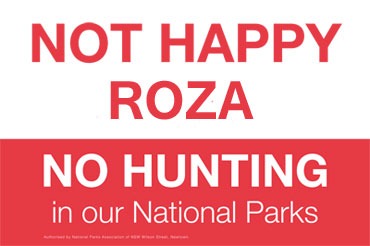 Blue Mountains protest campaign against the NSW Government’s local representative, Roza Sage MP,
and her undemocratic support for hunting in national parks across New South Wales.
Blue Mountains protest campaign against the NSW Government’s local representative, Roza Sage MP,
and her undemocratic support for hunting in national parks across New South Wales.
.
Two weeks later, on Sunday 15th July 2012, about 400 people rallied in Katoomba in the Blue Mountains to protest against Barry O’Farrell’s decision and to tell local Blue Mountains MP Roza Sage that they oppose the Government’s decision to allow hunting in our National Parks.
.
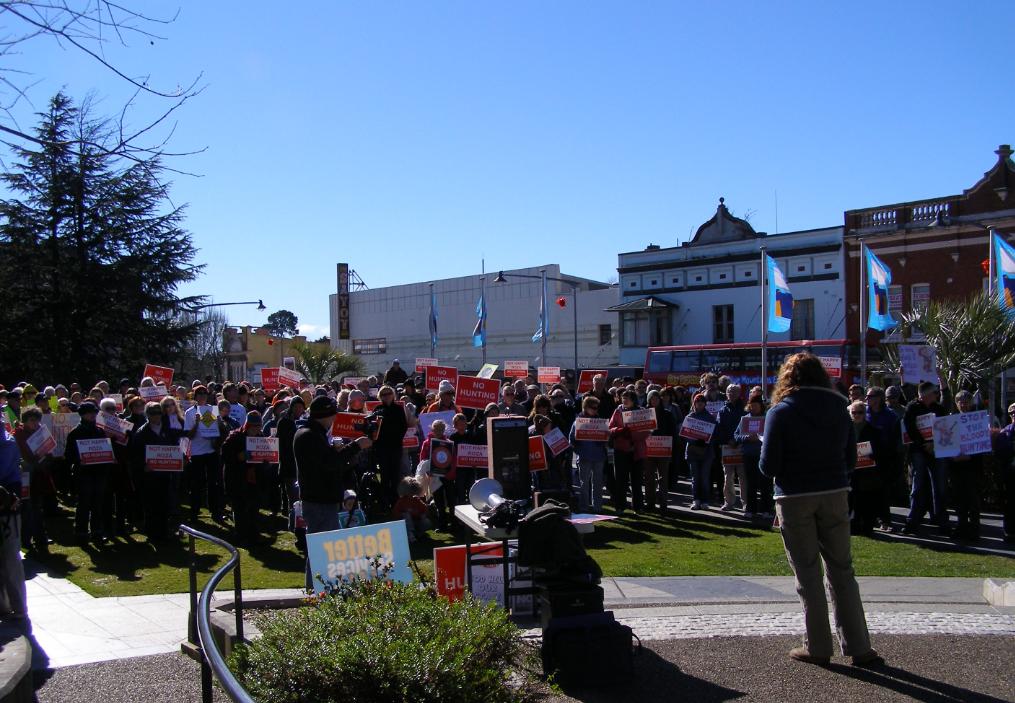 No Hunting in National Parks Rally at Katoomba
[Photo by Editor 20120715, photo © under ^Creative Commons]
No Hunting in National Parks Rally at Katoomba
[Photo by Editor 20120715, photo © under ^Creative Commons]
.
Kangaroo shot with arrow in Kosciuszko National Park
.
 Conservation Hunting
Conservation Hunting.
This kangaroo was discovered, still alive, two days ago near Log Bridge Creek picnic and camping ground on the Blowering Foreshore inside the Kosciuszko National Park, with the arrow right through its upper body.
<< An illegal hunter shot a kangaroo with an arrow and left it wounded near a camping area in the Kosciuszko National Park.
The roo was discovered yesterday near the Log Bridge Creek picnic and camping area on the Blowering Foreshore and was put down by parks officers.
NSW National Parks and Wildlife Service regional manager Dave Darlington:
“This roo spent an unknown time with an arrow pierced fully through its body and the cruelty and atrocity of this act is horrific. This is a senseless and disgusting act and we hope to prosecute the person responsible to the furthest limits of our legislation.”
Anyone with information is urged to phone NPWS on (02) 6947 7000 or Crime Stoppers on 1800 333 000.
.
Harming protected wildlife carries penalties of $11,000 an incident and up to six months jail while having a bow and arrow in a National Park also carries a fine of up to $3,300.
.
The National Parks and Wildlife Service had to euthanise a kangaroo.
.
National Parks and Wildlife Service does drug deal with hunters
.
<< A National Parks and Wildlife Service ranger was stood down for allegedly letting hunters into the Paroo-Darling National Park in the state’s far west in exchange for drugs.
The government confirmed there had been 12 investigations of illegal hunting in national parks in the past year.
.
..there had been 12 investigations of illegal hunting in national parks in the past year.
.
Shooters Party MP Robert Borsak is a clear example, having previously served as Game Council chairman under the Labor government.
There are fears that since the legislation allowing shooters to be part of controlled shooting operations in national parks has passed, many people believe they are allowed in there now.>>
[Source: ‘National Parks and Wildlife Service deals with drugs for hunting scandal in NSW’s west’, 20130701, by Andrew Clennell, Daily Telegraph (newspaper), ^http://www.dailytelegraph.com.au/news/nsw/national-parks-and-wildlife-service-deals-with-drugs-for-hunting-scandal-in-nsws-west/story-fni0cx12-1226672198301].
Illegal hunters trespassing on private land in metro Sydney
.
<< Hunters using guns and crossbows have been illegally entering private properties in metropolitan Sydney, forcing ecologists to abandon night-time observation of frogs and owls for fear of being shot.
Incidents have occurred in the past fortnight in north-west Sydney, just a few kilometres from housing, according to UBM Ecological Consultants’ Judith Rawling. The situation has become dangerous for her staff, she said, and she attributed the surge in illegal hunting to publicity over the looming introduction of hunting in national parks.
Local environment planning drafts for the Hills Shire have been released, prompting residents of bush blocks to apply for subdivisions.
”Before you put in a [development application] you have to put in a flora and fauna survey … That’s why we are coming across these shooters. This is really dangerous,” she said.
Game Council NSW was unavailable for comment.
Greens MP and firearms spokesman David Shoebridge:
“If local councils, the police and Game Council can’t control illegal hunting in the Hills Shire, there is no way on earth they will be able to regulate amateur hunting in far-flung national parks.”
.
[Source: ‘Hunters prowl across private land near city’, 20130630, by Kirsty Needham, Sydney Morning Herald (newspaper), ^http://www.smh.com.au/environment/animals/hunters-prowl-across-private-land-near-city-20130629-2p3v4.html].
Hunters shoot at a farmer near Game Council headquarters
May 2013:
.
<< Orange police are looking for two men who shot at a Springside farmer yesterday morning when he caught them illegally hunting on his property. [Ed: Springside is a community just south of Orange in central western New South Wales, where the Game Council of NSW has its headquarters].
The 43-year-old landowner was bailed up at gunpoint and ordered to drop his mobile phone which he was using to take a photograph of the offenders’ number plate. One of the gunmen smashed the phone and fired a warning shot at the man’s feet.
The farmer had challenged the men after he found them on his property hunting kangaroos. [Ed: Conservation Hunting?]
Canobolas Local Area Command Inspector Dave Harvey said the two men were less than four metres away from the farmer when they shot at him.
A command post was set up at Springside shortly before 10am where five police, detectives and the forensics special group combed through bushland in the Canobolas State Forest for two hours looking for the men. One of the men was wearing a grey top and black tracksuit pants. He is described as Caucasian, about 180cm tall, thin build with short dark hair and is between 17 and 24 years old. They were driving a white Subaru Outback.
June 2013:
.
<< Orange police have charged an 18-year-old man over last month’s shooting at Springside. The man is believed to be one of two people who shot at a farmer while illegally shooting on his property on May 21 at around 9.30am.
The alleged shooter was arrested in Orange’s central business district at around 11.50pm yesterday. Yesterday afternoon police obtained a search warrant for his Moad Street apartment where they found a number of items which police believe may be associated with the gun used in the shooting. Canobolas Local Area Command Acting Inspector Brenden Turner said police had not located the firearm. >>
.
[Source: ‘Hunters shoot at property owner’, 20130522, by Nicole Kuter, Central Western Daily (Orange-based newspaper),^http://www.centralwesterndaily.com.au/story/1517209/hunters-shoot-at-property-owner/; and ‘Hunter Police get their man: charges over hunting shooting’, 20130627, by journalist Tracey Prisk, Central Western Daily, ^http://www.centralwesterndaily.com.au/story/1599702/police-get-their-man-charges-over-hunting-shooting/?cs=103].
NSW Game Council bosses above the law?
.
<< The state government’s plan to allow hunting in national parks is in turmoil after the acting head of the Game Council was stood down on suspicion of illegal hunting.
The council is the body that will issue shooting licences under the scheme. Its acting chief executive, Greg McFarland was suspended on Tuesday night – along with a colleague – by the Primary Industries Minister, Katrina Hodgkinson, after Fairfax Media learnt of a police investigation into an incident near Mount Hope in central west NSW.
 Game Council’s acting chief executive, Greg McFarland
is currently the subject of continuing investigations
[Source: ‘Game Council to be abolished’, 20130704, by Sean Nicholls, Sydney Morning Herald State Political Editor
Game Council’s acting chief executive, Greg McFarland
is currently the subject of continuing investigations
[Source: ‘Game Council to be abolished’, 20130704, by Sean Nicholls, Sydney Morning Herald State Political Editorhttp://www.smh.com.au/nsw/game-council-to-be-abolished-20130704-2pdte.html]
.
At the centre of the investigation is a Game Council vehicle that was seen being driven through a national park without permission before allegedly breaking a fence and entering the privately-owned Karwarn cattle station in pursuit of a male goat with ”trophy horns”.
.
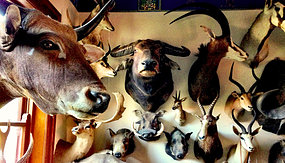 The Hunting Party
(Photo by Louie Eroglu)
The Hunting Party
(Photo by Louie Eroglu)
.
According to photographs taken by the owner of the 25,000-acre property, Diane Noble, the goat was shot in the gut – an act that contravenes the council’s own guidelines on humane, ”single shot” kills. Hunters sometimes avoid shooting a goat in the head to ensure the skull and horns can be hung as a trophy.
The incident happened on December 28 at the Noble’s Karwarn station, 110 kilometres south of Cobar. According to Ms Noble, the pair were confronted by a group of hunters who had paid to shoot at Karwarn. To access Karwarn, the pair had to drive through the Yathong Nature Reserve, run by the National Parks and Wildlife Service. A parks source confirmed they did not have appropriate permission to do so.
.
“If local councils, the police and Game Council can’t control illegal hunting in the Hills Shire, there is no way on earth they will be able to regulate amateur hunting in far-flung national parks.”
~ Greens MP and firearms spokesman David Shoebridge
.
..The suspensions call into question the O’Farrell government’s insistence that shooting will be safely and professionally run by the Game Council, which will issue licences and monitor compliance when shooting begins on March 1. Critics said the government must now reconsider its deal with the Shooters and Fishers Party to put the council in charge or abandon hunting in national parks altogether.
Steve Turner, the assistant general secretary of the Public Service Association, which represents park rangers, said: ”How can anyone have faith that hunting in national parks will be run safely? Imagine what’s going to happen when the rogues get going.”
The scandal comes a month after a risk assessment written by Premier Barry O’Farrell’s own department emerged, warning of a ”major risk” that bushwalkers and parks staff will be killed or seriously injured.
Ms Noble said she did not want to prejudice the investigation but was angered by the apparent conduct. ”The Game Council is supposed to promote ethical hunting. They shot the goat through the guts and that’s not ethical,” she said. ”The animal should be shot once in the head or the heart and lungs for a quick kill.” >>
.
[Source: ‘Game boss suspended over illegal hunt claim’, 20130123, by Heath Aston (political reporter), Sydney Morning Herald, ^http://www.smh.com.au/nsw/game-boss-suspended-over-illegal-hunt-claim-20130122-2d5nn.html].
July 2013: Time to Wind Up the Game Council racket
.
Dunn’s Review into the Governance of the Game Council was commissioned by the Government after an internal investigation into allegations that a senior member of the Council had been involved in the inhumane killings of the goat in Western NSW.
.
<<On Thursday 4 July 2013 the NSW Government announced it will implement the key changes to Game Council NSW recommended by the independent Governance Review of the Game Council of NSW by Steve Dunn, popularly referred to as The Dunn Report.
The changes are designed to improve the functions previously carried out by Game Council NSW and also acknowledge hunting as a legitimate recreational activity.
The report found that Game Council NSW had an ‘inherent conflict associated with its functions to both represent the interests of hunters, and to regulate their activities’.
Therefore the NSW Government said it will immediately take the following actions:
- Transfer the licensing, regulatory, enforcement, education and policy functions into the NSW Department of Primary Industries (DPI); and
- Establish an advisory Game Board that will undertake stakeholder engagement and representation, advocate hunting, advise on research priorities and commission research, and provide independent advice to Government.
The Director General of NSW Trade & Investment, Mr Mark Paterson AO, will become the Division Head of the Game Council Division in the interim to oversee the integration of functions into DPI.
The NSW Government also announced it will immediately suspend hunting in all 400 State forests, pending the transfer of functions and the outcome of a risk assessment. This means that individuals with written permission to hunt on declared public land areas such as State forests and Crown Lands must no longer do so and must abide by the suspension until further advised.
Game Council and the Forestry Corporation of NSW will be contacting licence holders who have booked Written Permissions as soon as possible. Advice is also being sought from the NSW Government on the status of licensing arrangements.
Game Bird Management regulatory functions will continue to be undertaken by the Office of Environment and Heritage in 2013 and will transfer to DPI in 2014.
.
Game Council NSW Media Statement
.
<<On Thursday 4th July 2013, the Minister for Primary Industries announced the dissolution of Game Council NSW as a result of recommendations made following the NSW Government’s governance review.
The NSW Government has suspended hunting in all NSW State forests, pending a new risk assessment. All issued Written Permissions are now invalid. Game Council and the Forestry Corporation of NSW will attempt to call all licence holders with bookings to confirm cancellation of their permits in the coming week.
Game Council is committed to working with the NSW Government as the report recommendations are implemented and will also be working closely with NSW game hunting licence holders to minimise the impact of interim arrangements. >>
[Source: Game Council NSW website, ^http://www.gamecouncil.nsw.gov.au/].
..Minister for Primary Industries (DPI), Katrina Hodgkinson MP said nominees for the board would be ministerially appointed based on merit and all existing 21 staff under the current Games Council would be transfered to the new structure under the DPI.
She said key in her decision to support Steve Dunn’s report recommendations was its finding that “more than a decade after it was established the Game Council has no overarching governance framework; lacks a strategic planning framework; lacks some of the skills, tools and resources to ensure effective compliance with its regulatory framework; has no internal regulatory compliance program, has no approved enterprise-wide risk management framework and has an inadequate policy framework”.
“I can’t just stand by and allow that to continue – I take full responsibility for the changes,” Ms Hodgkinson said.
She said one of her primary concerns was for staff employed in the area of compliance and their safety, but she also saw the need to restore confidence in the public in this area. >>
.
COMMENT by ‘Dickytiger’ 20130705:
.
“Good move. The Game Council was just a Shooters Party lurk, looking after their mates.
Hunting feral animals is vital, but it doesn’t require a crony bureaucracy to do it.”
.
Game Council NSW to be abolished
.
<< Amateur hunting in NSW forests will be suspended until at least October following the damning findings of a review into the Game Council of NSW.
As a result of the review, by retired public servant Steve Dunn, the Game Council of NSW will be abolished and responsibility for licensing of amateur hunters transferred to the Department of Primary Industries, the state government announced on Thursday.
The concerns raised in the review have led the government to announce the suspension of all amateur hunting in state forests until governance issues identified within the council are resolved.
In a simultaneous announcement, Environment Minister Robyn Parker revealed the introduction of amateur hunting to national parks will proceed in October, but on a trial basis in 12 parks. Pending the results, hunting may be rolled out in up to 75 parks and reserves as previously announced by the government under a deal with the Shooters and Fishers Party.
Ms Parker said the rules for shooting in national parks would be significantly different to those in place for state forests. Shooters would be closely supervised by National Parks and Wildlife staff in all areas where shooting takes place, which will be closed to visitors for the duration. Shooting will not take place during school holidays.
Additionally, no one under 18 would be allowed to participate, and use of bows or black powder muskets would be prohibited.
The Dunn report, released on Thursday, slams governance the Game Council, which it says is ‘‘deeply embedded in politics’’.
In a scathing assessment, Mr Dunn says public safety ‘‘does not receive a high level of attention’’ in planning documents prepared by the organisation, which is responsible for overseeing licensing of amateur shooters in NSW.
He says the council has been unable to resolve the ‘‘inherent conflict of interest’’ between representing the interests of hunters and regulating their activities in NSW.
The report says the council has ‘‘achieved significant results’’ since its establishment in 2002. But they have been achieved ‘‘at the taking of governance risks not normally associated with government bodies.’’
It concludes: ‘‘Allowing the Game Council to continue on its current path is not an option.’’
The review was ordered by Mr O’Farrell in March after an investigation found alleged illegal hunting by two Game Council senior employees on a property in outback NSW.
.. The IAB report also identified ‘‘possible breaches of Game Council policies and procedures, information which raises questions about governance procedures within the Game Council’’.
Sensitivity over the allegations were heightened by the decision by Mr O’Farrell to open NSW national parks to amateur hunting.
The decision was part of a deal between the government and the Shooters and Fishers Party, which holds the balance of power in the upper house, over passage of electricity privatisation legislation.
Mr Dunn’s report notes that the Game Council was established in 2002 because of the ‘‘influence and power’’ of the Shooter and Fishers Party. He says this power has resulted in the creation of an organisation lacking in accountability.
Shooters and Fishers Party MP Robert Brown is a former Game Council chairman.
More than a decade after the Game Council was established, a strategic plan has yet to be finalised and made public, Mr Dunn notes. His report recommends the 18-member Game Council be replaced by a NSW Game Board of not more than eight members.
It would be subject to control of the department and be responsible for representing the interests of hunters, promoting feral animal control and providing policy advice to government.
However, licensing, education and law enforcement functions – currently the chief role of the Game Council – would be handed to a government department, along with policy and legislation functions. Reaction is being sought from Game Council chief executive Brian Boyle and the Shooters and Fishers Party. >>
[Source: ‘Game Council to be abolished’, 20130704, by Sean Nicholls, Sydney Morning Herald State Political Editor, ^http://www.smh.com.au/nsw/game-council-to-be-abolished-20130704-2pdte.html].
Hunting on NSW public land will be banned for at least the next two months and the Game Council will be disbanded. Yet the NSW Government is going ahead with its plan to allow volunteer hunters in national parks as part of a pest control program.
It’s a bold decision, which the Shooters and Hunters Party says even it had no idea was coming. This decision stems from the results of the Government commissioned Dunn Review into the governance of the Game Council. >>
.
Dunn’s Scathing Review
.
Dunn’s Review into the Governance of the Game Council was commissioned by the Government after an internal investigation into allegations that a senior member of the Council had been involved in the inhumane killings of a goat in Western NSW.
The final report acknowledged the Council had achieved many things in its years of operation but for the most part the report was undeniably shocking leaving the Government no choice but to take action.
Its author Steve Dunn questions how things got so bad. He found the Council has no overarching governance framework, lacks the skills and resources to ensure effective compliance and found breaches of record keeping and privacy legislation. The Game Council is a statutory body established under the Game and Feral Animal Control Act – and it should be subject to the control and direction of the Minister for Primaries Industries.
But Premier of NSW, Barry O’Farrell, says the Council strayed.
“Essentially it made the point that the Game Council was both the promoter and the operator in relation to hunting activities across NSW as well as the regulator,” he said. “That posed an unacceptable risk to the Government.”
The review found the Game Council has its fingers deep in the political pie, with the slices getting bigger thanks to the influence and power of the Shooters and Fishers Party in the NSW Legislative Council.
Steve Dunn wrote, “the Game Council has no parent and no siblings, no one wants to adopt it and no one really wants a close relationship with it, because of the politics.”
Shooters Party MP, Robert Brown, says he hasn’t yet had time to fully consider the O’Farrell Government’s announcement. But he says he’s personally disappointed the Game Council has been abolished and will be seeking a meeting with the Premier before he forms the Party’s response.
The Game Council will be replaced by an advisory board of no more than eight members, which will each be selected on merit, rather than being appointed by various organisations. The board will be in charge of advocacy. The regulatory aspect of the Council will now go to Department of Primary Industries.
Minister Katrina Hodgkinson says no Games Council jobs will be lost in the transition and, until that situation is fixed, shooting in state forests has been put on hold.
“It’s a hard thing to have to go through and accept a report which is so critical of an organisation. But we’ve got an opportunity now to make things right and make things good. We’ll be transferring the operations of the Game Council over into the Department of Primary Industries, which does have excellent governance.”
The temporary shooting stoppage will affect 400 state forests and 2 crown lands. However the Government is going ahead with its pest control program National Parks.
A trial in 12 parks will commence in October. The Environment Minister Robyn Parker says it will be regulated and managed by the National Parks and Wildlife Service, and there will be strict controls and supervision.
The Minister acknowledged the 20,000 hunters in NSW that assist the Government with pest animal control in NSW.
“These hunters have played an important role in pest eradication.”
The Game Council and the Shooters and Fishers Party have been contacted for comment.
A one time candidate of the Shooters and Fishers Party says he’s always had concerns about the way the Game Council has been run. Jim Pirie is from Mudgee in New South Wales and has over 60 years of hunting experience under his belt, he was also a one-time candidate of the Shooters and Fishers Party. These days he’s the owner of a gun shop in town and he’s also the Treasurer of the Cudgegong Valley Hunters Club.
He spoke with the ABC’s Angela Owens frankly about his concerns over opening National Parks up to hunters and the growing power base of the Game Council.
.
“Unfortunately the architects of all this are very egotistical, arrogant men and they won’t take advice from anybody,” he said. “It’s either their way or the highway.”
.
“(Someone) stood up at a hunting organisation meeting one day and said there was no nepotism, no cronyism in the Game Council, well that was a joke.
“They appointed the people that they wanted and this at the end of the day was to the determent of the organisation.” >>
.
[Source: ‘NSW Government abolishes Game Council’, 20130705, by Skye Manson, Lisa Herbert and Angela Owens, ABC Rural, ^http://www.abc.net.au/news/2013-07-05/nrn-game-council-gone/4800282].
.
July 2013: Cowboy shooters are finished in NSW
.
.
“DANIEL BOONE”
lyrics by Vera Matson, music by Lionel Newman
.
<< Daniel Boone was a man,
Yes, a big man!
With an eye like an eagle
And as tall as a mountain was he!
Daniel Boone was a man,
Yes, a big man!
He was brave, he was fearless
And as tough as a mighty oak tree!
From the coonskin cap on the top of ol’ Dan
To the heel of his rawhide shoe;
The rippin’est, roarin’est, fightin’est man
The frontier ever knew!
Daniel Boone was a man,
Yes, a big man!
And he fought for America
To make all Americans free!
What a Boone! What a doer!
What a dream come-er-true-er was he!
Daniel Boone was a man!
Yes, a big man!
With a whoop and a holler
he c’d mow down a forest of trees!
Daniel Boone was a man!
Yes, a big man!
If he frowned at a river
In July all the water would freeze!
But a peaceable, pioneer fella was Dan
When he smiled all the ice would thaw!
The singin’est, laughin’est, happiest man
The frontier ever saw!
Daniel Boone was a man!
Yes, a big man!
With a dream of a country that’d
Always forever be free!
What a Boone! What a do-er!
What a dream-come-er-true-er was he! >>
.
[Source: ‘DANIEL BOONE’, lyrics by Vera Matson, music by Lionel Newman, Twentieth Century Music Corporation, 1964, New York, NY, USA, ^http://www.danielboonetv.com/themesong.html].
The Game Council’s Cowboy Days Are Over
.
<< The cowboy days are over for the recreational shooting of feral animals in NSW. A damning exposé of what the hunting regulator, the Game Council of NSW, has been up to over the past decade- written by a senior public servant who grew up in rural England, familiar with gun safety – makes astonishing reading.
Steve Dunn describes a politically untouchable posse of gun wielding vigilantes, who enthusiastically set themselves the goal of stopping illegal hunting – despite this actually being the job of police. Dunn says the Game Council was acting beyond its statutory role, and with an inherent conflict of interest. Ultimately they posed an unacceptable risk to the government. The Game Council has now been disbanded by the O’Farrell government.
Boring paper pushing, policy making, analytical or investigations skills weren’t seen as important to this bunch of Wild West public servants. The top job prerequisite to become a game council officer was to be a hunter, and to promote hunting.
Left to their own devices by successive ministers, the game council roamed forest frontiers from its head office in Orange, apparently unconcerned about issues of public safety, promoting their own novel concept of ”conservation hunting”, and cloaked from government oversight.
The Game Council’s website last week boasted of a surge of dead animals last financial year: a ”staggering” 1.23 million animals killed on private land by its hunters, and 21,000 shot on public land. And that these figures meant a 70 per cent increase in its key performance indicator.
But Dunn says the council was confused about its role under the Act. It wasn’t supposed to be tallying carcasses, but instead developing plans for hunter safety, public land access, licensing, education, compliance of licensed hunters and research.
The council considered themselves to be outsiders to other government agencies, who reported the renegades to be combative, assertive, and too aligned with the interests of the hunters they were supposed to be regulating.
The review described a pariah that no other government department could love. If agencies are generally organised into clusters, with small agencies needing both a parent and siblings to survive, the game council was an orphan.
”The Game Gouncil has no parent and no siblings, no one wants to adopt it, and no one really wants a close relationship with it – because of politics,” Dunn wrote.
Established in 2002 under the Labor government, the council had its roots ”deeply embedded in politics”, and arose because of the importance of the Shooters & Fishers Party to the government of the day in the upper house when governments needed to get legislation passed.
.
The council complained it had an image problem in the wider community. But Dunn’s report considers it was a problem of the council’s own making.
.
Carrying private firearms in agency vehicles and hunting on the job are not a good look for public servants. Was it appropriate for the hunting regulator to be handing out promotional stress balls that say ”Stressed? Go conservation hunting”?
In the fallout from the Dunn Review, the Game Council’s regulatory, enforcement, licensing and policy roles have now been transferred to the department of primary industries. A separate advisory Game Board will be formed to represent hunters and advocate hunting.
As the government prepares to allow licensed volunteer shooters to be involved in supervised National Parks and Wildlife Service culls of feral animals in 12 national parks in October, the cowboys that once reigned are out. Strict guidelines for the culls, which will only be held when parks are closed to the public, stipulate: no night shooting, no dogs, no bows and arrows – and no shooting from horses. >>
.
[Source: ‘Cowboy shooters are finished in NSW’, 20130707, by Kirtsy Needham, Illawarra Mercury newspaper, ^http://www.illawarramercury.com.au/story/1621471/cowboy-shooters-are-finished-in-nsw/].
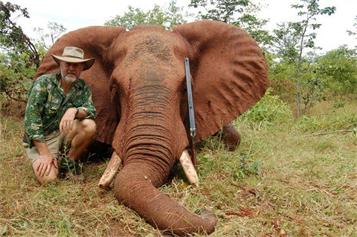 Shooters Party, Robert Borsak with his Big Game kill
~ an African Bull elephant shot on safari in Zimbabwe in June 2008.
[Source: ABC Four Corners, ^http://www.abc.net.au/news/2013-06-11/nsw-mp-robert-borsak-with-an-elephant-shot-on/4745476]
Shooters Party, Robert Borsak with his Big Game kill
~ an African Bull elephant shot on safari in Zimbabwe in June 2008.
[Source: ABC Four Corners, ^http://www.abc.net.au/news/2013-06-11/nsw-mp-robert-borsak-with-an-elephant-shot-on/4745476]
.
<< New South Wales Shooters MP Robert Borsak says there has been a culture war over gun control in Australia since the Port Arthur massacre, but he believes people are starting to “get over it.” Mr Borsak believes semi automatic weapons, which were banned in the wake of the 1996 massacre, should be put back in the hands of hunters and recreational shooters. >>
[Source: ‘NSW Shooters MP Robert Borsak says people are ‘getting over’ the Port Arthur massacre’, ^http://www.byronevents.net/nohunting/index.html].
.
Further Reading:
.
[1] The Dunn Report (The Governance Review of the Game Council of NSW by Steve Dunn of Independent Consulting, 14th June 2013)
>Download Report (59 pages,1.1MB, PDF)
.
[2] Interview with Robert Borsak, NSW Shooters and Fishers Party – ABC News
ABC Four Corners, ^http://www.abc.net.au/news/2013-06-11/interview-with-robert-borsak-nsw-shooters-and/4745720
.
[3] NSW MP Robert Borsak with an elephant shot on safari in Zimbabwe – ABC News
^http://www.abc.net.au/news/2013-06-11/nsw-mp-robert-borsak-with-an-elephant-shot-on/4745476
.
[4] NSW Shooters MP Robert Borsak says people are ‘getting over’ the Port Arthur massacre – ABC News
^http://www.abc.net.au/news/2013-06-11/shooters-mp-says-people-27getting-over27-port-arthur/4745472
.
[5] PM – Shooters and Fishers Party says agreement with NSW Govt over 15/07/2013
^ABC, 20130715, ^http://www.abc.net.au/pm/content/2013/s3803487.htm
.
[6] Mixed reaction to shooters in state’s national parks – (none) Country Hour – ABC Rural Australian Broadcasting Corporation)
ABC, 20130720, ^http://www.abc.net.au/site-archive/rural/sa/content/2013/02/s3693724.htm
.
[7] The Hunting Party – Four Corners
‘The Hunting Party’, 20130610, ABC,^http://www.abc.net.au/4corners/stories/2013/06/10/3776198.htm
.
[8] Shooting in Paroo-Darling NP on hold – ABC Broken Hill – Australian Broadcasting Corporation
A controversial plan to allow hunting in 79 national parks including the Paroo-Darling National Park in far west NSW near White Cliffs has been delayed indefinitely, 20130220, ABC, ^http://www.abc.net.au/local/audio/2013/02/20/3694440.htm
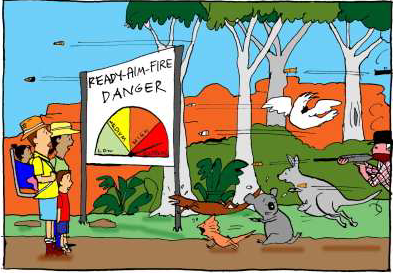

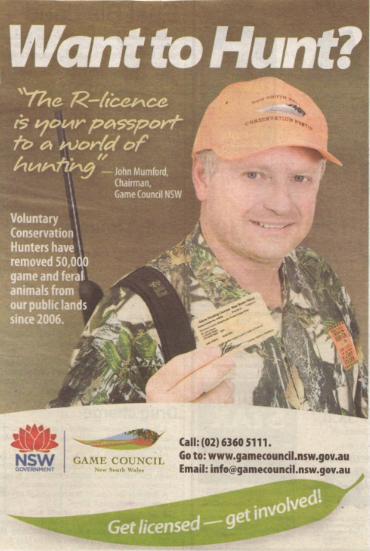

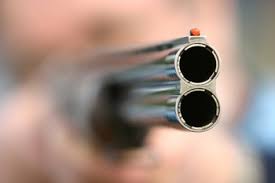
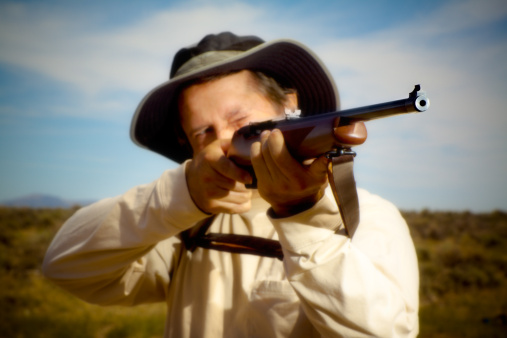
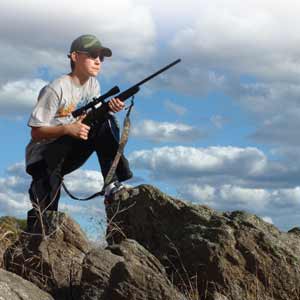
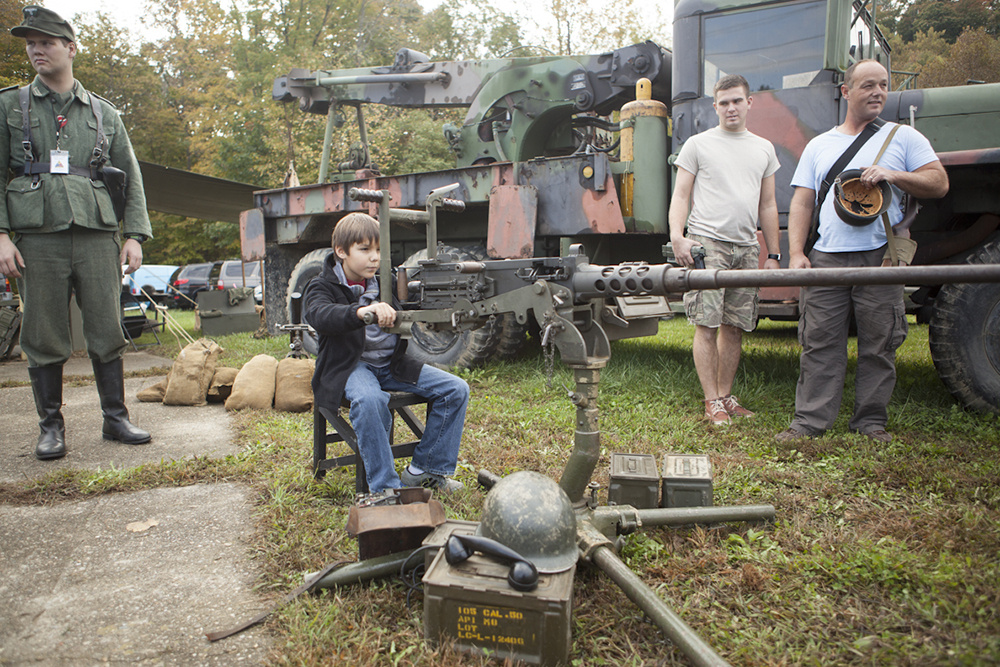
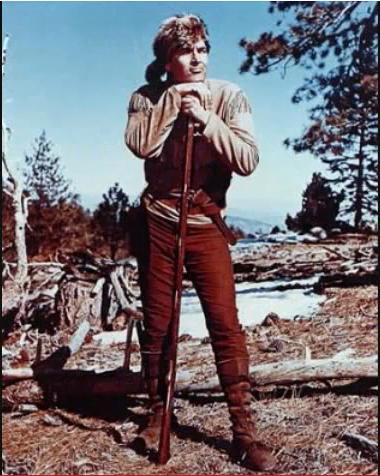
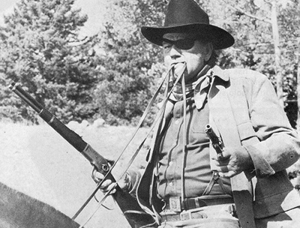
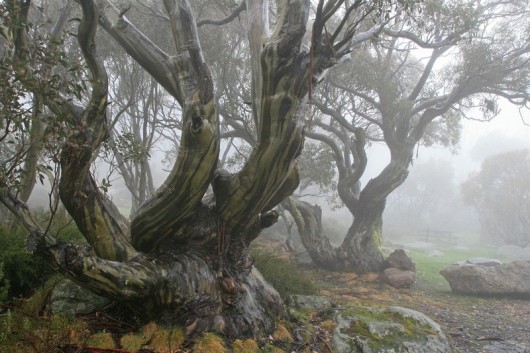
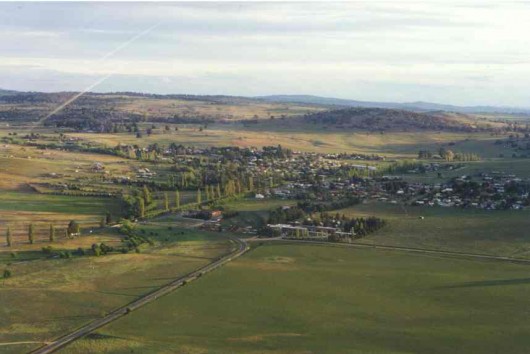
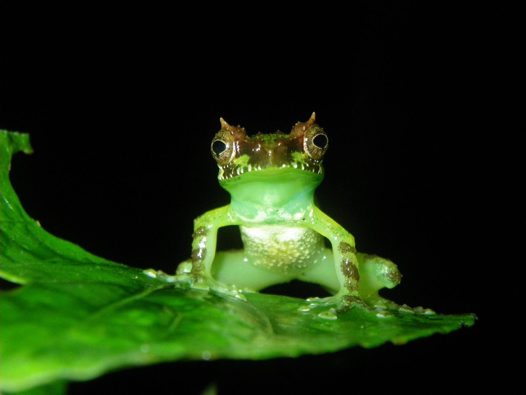
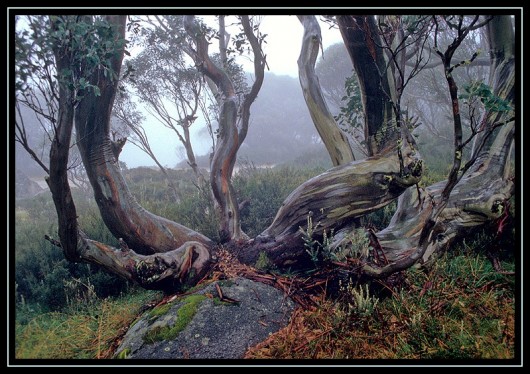 Snow Gums do not enjoy being burned to death
Snow Gums do not enjoy being burned to death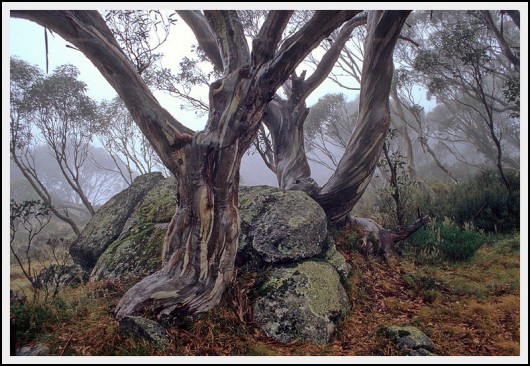
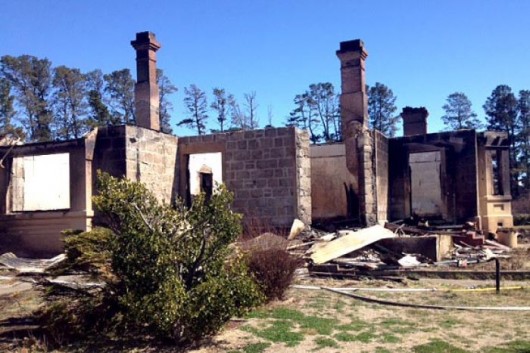

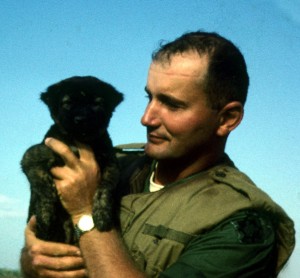 Captain Michael D. Miller in 1968
[New life amongst so much death]
Captain Michael D. Miller in 1968
[New life amongst so much death]
